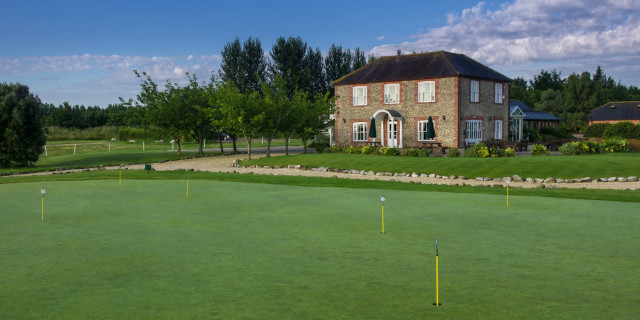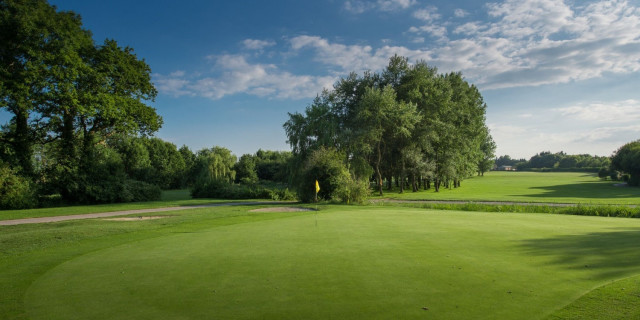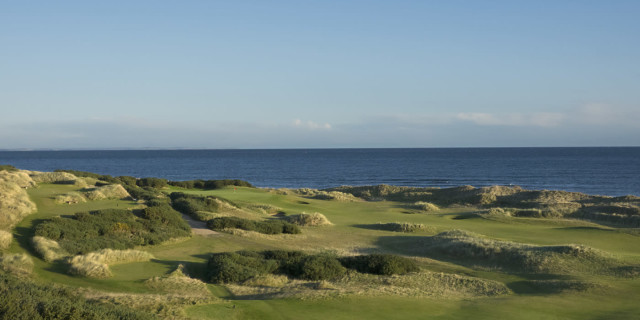Chichester Golf Club Feature Review
Review by Will Trinkwon
Chichester Golf Club is one of the largest golf centres in Sussex and Highly Recommended on Golfshake. This is both its asset and its bane. The club has two courses – five if you include its 9-hole par-3 course (recently upgraded to double-up as a ‘foot golf’ course) and the two crazy golf courses which have recently been added to the premises – the Tower, which is the easier and less established of the two tracks, and the Cathedral, the older and more difficult. My recent visit to the club was centred around the latter – I wanted a challenge. However, I found it impossible to escape the influence of the club’s other, more corporate aspects, my overall experience being marred by what felt like an identity crisis.
Chichester was founded in 1990 by a local farming magnate named Brian Langmead, beginning life as arable farmland before he spotted its golfing potential and transformed it into what is now the Tower course. A 9-hole par 3 course was quickly added, along with a driving range and a crazy golf layout (recently replaced and upgraded). The Cathedral Course was instituted four years later in 1994. The Cathedral Course is not built on the most inspiring of land, but the course has an arable charm and is a pretty, if not breathtaking, parkland. It’s also well-designed and at 6,442 yards, par 72, offers a good test for all levels of golfer. Its condition, however, left something to be desired, and, as good as the course is, I couldn’t help feeling like it had the potential, with a bit more investment, to be so much better. My overall impression of the club was also damaged by an overly corporate feel, the feeling that the club’s real interests lay in appealing to holiday makers, as opposed to creating a top golfing experience.

Pre-Round Thoughts
The journey from Chichester’s entrance to the first tee of the Cathedral Course encapsulates these difficulties. The estate is split into two parts. The first section, which is nearest the entrance, comprises a kind of golfing amusement park which sits uneasily with what you’d expect from a traditional club. Here, you’ll find not one but two crazy golf courses (one jungle-themed, which looked fun, and an indoor deep-sea-themed alternative which I didn’t see so can’t judge), a driving range and what bills itself as a par 3 course, but appeared to be more targeted towards ‘foot golf’ (kicking footballs instead of hitting golf shots) and aimed at holiday makers rather than golfers. While a lot of this stuff looked like a good laugh, it didn’t really feel very congruent with the more traditional aesthetics of a golf course. Although this is spatially separate from the Tower and Cathedral courses, you have to drive past it to get to the main tracks and this may be off-putting to the more serious player. As first impressions go, it’s certainly not, to my mind, the most stellar one. And the corporatized overtones inaugurated a feeling that would loom over my day.
Down the course end, however, things are thankfully more serious. The clubhouse, a converted Sussex flint farmhouse, is lovely to look at and while the interior isn’t quite so attractive, this is more than made up for by the loveliness of the bar staff who are professional but with a bantering touch. The food is old school pub fare, which is hearty, but perhaps overpriced. The clubhouse is accompanied by a well-stocked pro-shop (there’s another down the crazy golf end), whose staff are again a delight, and a practice putting and chipping green outside. There is also, as I’ve already mentioned, a driving range down the other end of the complex. This is well-furnished, with plenty of nicely-conditioned bays. There are also a generous amount of targets – including nets and multi-ringed greens – to aim at and although the overall feel is perhaps a little gimmicky, its undeniably a great place to warm up before a round.
Front 9 Overview
As I said in my introduction, the Cathedral Course has the potential to be a quality track. The course opens with an intimidating tee shot that demands that the golfer concentrate from the start. The fairway is not narrow, but is flanked by thick trees and shrubbery on the right and out of bounds on the other side. Pull your tee shot ever so slightly, as I did, and it’s easy to run out of ground.
This early emphasis on accuracy sets the tone for rest of the round. 13 of the 18 holes feature some kind of water hazard and, with a few notable exceptions, all of them are comparatively tight. The 5th hole, affectionately nicknamed ‘The Mother’, is a case in point. At 608 yards, the par 5 is one of the longest in Sussex and it also demands laser-like accuracy. Miss the fairway by only a handful of yards on either side and you’ll be fishing about in a red-staked ditch, ruing a lost ball and another lost shot. As if that wasn’t bad enough, the fairway tapers in as you near the green and your second and third shots must be threaded between water hazards onto a tongue of fairway that is only about 30 yards wide. There’s a reason this hole is stroke index 1 on the scorecard, and it more than lives up to the hype.
The other standout hole on the front nine for me is the 7th. Like the difficult 5th hole, the 7th is tight. If you hit driver, you can be left with only a short iron approach, but a large stream and/or shrubby wasteland will catch any drive that goes slightly wide. The smart play is to hang back with a 3-wood or a long iron and accept a longer shot in. Problem is, the brook carries on right up to and ahead of the front of the green. This makes for an intimidating vista, especially with a long iron in hand and means that the player has to fly their approach the whole way if they don’t want to find a watery demise. It’s a beautifully designed hole that gives the golfer options and requires sharp shot-making to earn a par 4.
In terms of condition, the fairways on the front nine were mown nicely and there was a pleasing amount of definition between the greens, the short grass and the first and second cuts of rough. The greens themselves, however, unfortunately left something to be desired. I don’t know what stimp they were running at, but they played very slow. Even downhill putts needed to be ‘hit’ not ‘stroked’ and, visually, the greens looked hairy, as though the grass was too long. They were also quite bobbly and hidden knobs often bumped even the most perfectly struck of putts off-line. My playing partner was also unhappy with the greens, so it wasn’t that I was imagining this. I’ve certainly putted on worse, but Chichester’s greens were disappointing considering the strength of the course design.
Another area which needs work is the bunkers, which were uniformly too shallow and, in some places, perilously low on sand. The quality of what sand there was there was also quite poor, gritty and littered with stones. From an aesthetic point of view, they might also be more neatly defined.
Back 9 Overview
The Cathedral’s frontnine9 is one of the toughest I’ve played, but it’s back nine offers a welcome relief. This side opens with a short par 4 of 332 yards, a sharp dogleg left which is drivable if you can hit a long draw. The real scoring holes on the back nine, however, come in the form of two reachable par 5s – the 12th, which is only 480 yards long, and the 14th, which is bang on 500. The former is a great risk and reward hole: a strong drive leaves a second over an imposing lake which will swallow a mishit approach. A newly created bail-out area down the left gives the player a way out, but this leads to your approach being blocked out by a tree. This was one of my favourite holes on the back nine. The other standout holes for me were the 13th – a 150 odd yard par three where a pond hugs the green down the left-hand side – and the 15th – another great short hole, with a raised green surrounded by a moat of bunkers and 300 beautiful Portland stones. These form a natural amphitheatre for a tricky tee shot.
At just 2,940 yards, but with a par of 36, the back nine is considerably shorter than the front nine (same par, but over 3,500 yards) and offers the opportunity for the in-form golfer to rescue a score. If you’re not firing on all cylinders, however, there’s still plenty of ways to get into trouble. The Cathedral course retains a sting in its tail right until the very end.
Condition wise, the greens on the back nine were similar to those on the front, but perhaps a little purer in places. The bunkers were also unchanged.

Post-Round Thoughts
Overall, Chichester Golf Club has a bit of an identity crisis. On the one hand, the Cathedral course is a really very well-designed test. Its recurrent water features provide nice vistas and also add difficulty, giving even the most sure-footed of ballstrikers something to think about. The really nice thing about the course is that so many of the holes are risk and reward. The contrast between the back nine and the front nine is aesthetically pleasing and the possibility of a good finish means that the obligatory post-round pint is almost guaranteed to taste sweet. On the other hand, however, the course seems to suffer from underinvestment. The holiday park-like facilities that cluster around the club’s entrance may leave the more serious golfer with a bad taste in their mouth. More damningly, the condition of, at least the Cathedral Course, is underwhelming and makes what could be a really great track into a bit of a damp squib. The onus seems to be on running a tight business, rather than chasing a top golfing experience.
Chichester’s identity problem is encapsulated in the green fees they charge for a round. The Cathedral Course costs a whopping £40 to play at the weekend before 3pm, £25 after it (though there is a £5 discount if you book online). By way of comparison, a round at Bognor Golf Club, which is a much more classical members club with, to my mind, a much better course, is only £35 at the weekend before 3pm, and £25 after it. This is also the same price as a round on the brilliantly conditioned Goodwood Park (£40 between 12 and 3pm on weekends and £25 after) which is a better track than either Chichester or Bognor and in orders of magnitude of better condition. The Cathedral Course’s high price tag places it in direct competition with these other courses, both of which blow it out of the water. If Chichester wants to remain competitive, it needs to either invest in its courses, or lower its prices.
Verdict
Playing at Chichester was a good but frustrating experience. The Cathedral Course is well-designed and has the potential to be a really great parkland. Unfortunately, the course was let down by its inconsistent condition, the, to my taste, too-corporatised overtones of the club and what seemed to be a lack of investment in the actual course. The loveliness of the bar and pro-shop staff, as well as a few stand-out holes, though, meant this was still a decent golfing day-out.
Top Tips
- The Cathedral Course is saturated with water hazards so accuracy off the tee and approach shots is a must. Consider whether you really need to take on that long carry, or whether a lay-up may be really more prudent.
- The greens are slower than most so a mallet putter may be better than a blade. You’re going to have to give putts a whack and will benefit from the added ‘beef’.
- Don’t worry if your score isn’t great coming off the front nine. The first nine holes and tough and are more about surviving. The back 9 is where you rescue your score.
Overall Rating – 6
Course (Conditions) – 5
Course (Hole Variety/Layout) – 6.5
Course (Green Conditions) – 4.5
Course (Challenge/Difficulty) – 7.5
Club Facilities & 19th/Clubhouse – 7
Practice Facilities – 7.5
Pace of Play – 7
Value for Money - 3
Related Content: review England course
What do you think? post your thoughts and feedback on the Golfshake Forum: https://forum.golfshake.com/

















